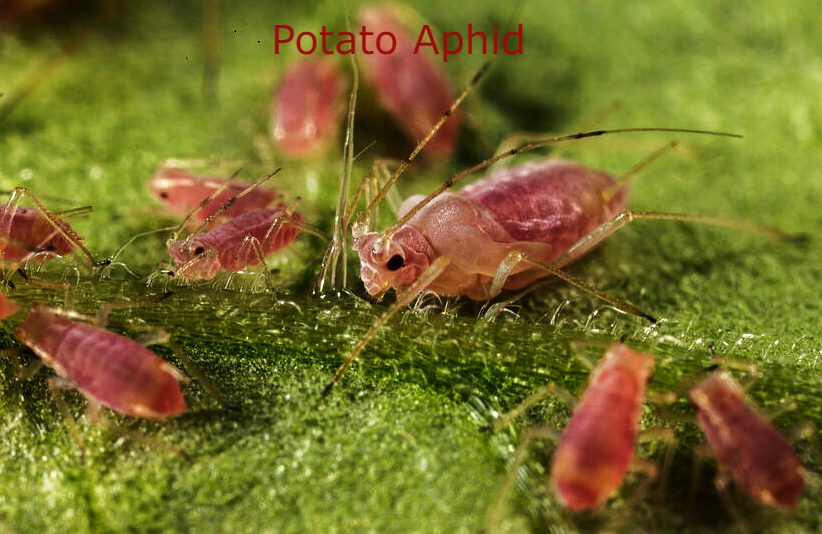Potato Aphids
Myzus persicae, known as the green peach aphid, greenfly, or potato aphid, is a small green aphid. Aphid is the most dangerous insect for potato plants. Potato Aphids damaged potatoes essentially by spreading plant infections. Infrequently, aphids become so bountiful that their taking care debilitates the plants. Potato leafroll infection is spread by the two aphids. Yet the green peach aphid is by a wide margin the more compelling vector. Early season leafroll contamination stunts the plant. Plants developed from tainted seed potatoes won’t deliver attractive potatoes. A contaminated Chestnut Burbank potato regularly has phloem net rot, earthy colored staining inside the potato that decreases quality. The earthy-colored staining is generally serious at the stem end however may broaden all the way into the tuber. White Rose and red-cleaned assortments don’t foster net putrefaction. Other infections spread by aphids incorporate cucumber mosaic and hay mosaic (calico).
Identification of aphids
The damage that whiteflies cause to potato crops was discussed in the earlier post that was written about whiteflies. In this essay, we will discuss the phenomenon of slow oiling of potatoes as well as the ways in which this phenomenon can be harmful to a crop of potatoes. And how to find a solution to the problem using natural means, biological methods, and chemical ways. First and foremost, become familiar with it and learn how to recognize it. There are two types of aphids in potatoes.
- Potato Aphids

- Green Potato Aphids

- Peach Potato Aphids

The potato aphid often begins its attack in the lowest portion of the plant before moving up to cover the entire plant. The green sloth’s adult aphids have wings and are either bright green or yellow. On its body, there are dark markings. Some of the adult insects are wingless and light greenish in color, whereas the immature insects are pink, light greenish, or yellow. The potato aphids’ adults are long and lean. He has quite long legs. On its body, there are green grains. They typically have a green color. It can, however, also be pink and red. Red may be present in the wings of adult moths. The peach aphid is a little bigger than other varieties. The antennae on their heads make them easy to identify. Aphid antennae are distinctive. In contrast, the green aphid’s antennae are attached top to top.
Damage Symptoms of Aphids
Potato aphids are generally the cause of the spread of the disease. But as their population grows, they feed on the plants, weakening them. Both potato aphids are dangerous and cause the virus. The more lethal variety of teal is the green variety. The virus that causes leaf curl kills plants. The attack not only kills the plant but also severely degrades the quality of the potatoes produced there. The damaged plant develops a brown mark on its potatoes. For all eating and other purposes, this destroys potatoes.
Treatment Method Aphids
If you want to keep potato aphids at bay, you should implement a coordinated spraying program. Regular weeding of the area around the potato crop is essential for keeping the crop under control. Let us know how to control potato aphids.
Biological Control of Potato Aphid
Aphids are a target for numerous parasites and predators. Lady beetle larvae, lacewing larvae, and syrphid fly larvae are common predators. The parasitic fungus Entomophthora aphids reduce green peach aphid populations in the winter. Most aphid control products on the market are extremely harmful to populations of predatory insects.
Cultural Control of Aphids
The spread of potato aphids is exacerbated by the presence of weeds in noncultivated areas such as ditch banks, roadways, farm yards, and other such places. In the potato-growing regions of the Central Valley and the South, Malva serves as a crucial overwintering host. Early-season host plants where aphid populations rise before spreading to other host plants, especially commercial potatoes, include tumble mustard (Sisymbrium altissimum), pennycress (Thlaspi arvense), and other mustards.
The potato leafroll virus relies on nightshades and volunteer potatoes, thus eradicating these plants is crucial. Destroying individual rogue diseased potato plants can help stop the spread of disease throughout a field. Maximum efficiency requires eradicating not only the infected plant but also the three neighbors in the immediate row and the three nearest plants in the rows on either side. When it comes to planting seeds, roguing is crucial.
Aphids In Potato
Aphids can indeed be a problem for potato plants. These tiny insects feed on the sap of plants and can cause damage by weakening the plant, reducing yield, and transmitting diseases. Here are some steps you can take to control aphids in your potato plants:
Natural Predators: Encourage natural predators of aphids such as ladybugs, lacewings, and parasitic wasps. Hose them off: Use a strong jet of water from a hose to physically remove aphids from the plants.
Neem Oil: Neem oil is a natural insecticide that can be effective against aphids. Dilute it according to the instructions on the product label and spray it onto the affected plants.
Insecticidal Soap: Insecticidal soaps are also effective against aphids and are less harmful to beneficial insects. It can be effective against aphids but should be used with caution as it can also harm beneficial insects.
Row Covers: Using row covers can prevent aphids from reaching your potato plants in the first place. However, make sure to remove the covers once the plants start flowering to allow for pollination.
Rotate Crops: If possible, rotate your crops each season to help disrupt aphid populations. This can prevent them from building up in the soil and affecting your potato plants.
Prune Infested Areas: If you notice any heavily infested parts of the plants, you can prune them off to prevent the spread of aphids to the rest of the plant.
